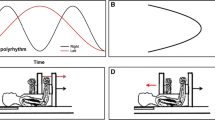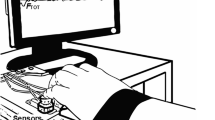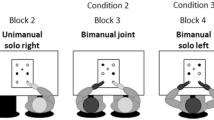Abstract.
Upper limb coordination was studied by examining pattern stability of between-hand rhythmical coordination. In the first of two experiments, relative phase of rhythmical wrist flexion-extension was examined within a kinesthetic tracking paradigm. Eight right-handed subjects actively tracked a driven hand being flexed and extended by a computer-controlled AC servo-motor. Hand movements were constrained in flexion or extension. The simultaneous contraction of wrist flexors and extensors was defined as inphase (IP) and the alternating contraction of wrist flexors and extensors as antiphase (AP). Phase transitions (from AP to IP) were observed in 16% of trials prepared in AP. Fewer phase transitions occurred when the right wrist was constrained in flexion, and also when the left wrist was constrained in extension. IP patterns were performed with greater stability than AP patterns. These effects were explored further in a second experiment with the addition of a secondary probe reaction time task to assess demands on central capacity, and the analysis of wrist flexor and extensor electromyographic activity. Subjects returned longer reaction times for AP than IP movement, suggesting the AP movement pattern placed a greater demand on central capacity than the IP movement pattern. During this kinesthetic tracking task, similar dynamic principles emerged as those observed during bilaterally active bimanual rhythmical coordination. The greater stability of the hand-posture combination where the driven left hand was constrained in extension and the active right hand was constrained in flexion may be a demonstration of unique central control of coupled activity.
Similar content being viewed by others
Author information
Authors and Affiliations
Additional information
Electronic Publication
Rights and permissions
About this article
Cite this article
Stinear, J., Byblow, W. Phase transitions and postural deviations during bimanual kinesthetic tracking. Exp Brain Res 137, 467–477 (2001). https://doi.org/10.1007/s002210000665
Received:
Accepted:
Issue Date:
DOI: https://doi.org/10.1007/s002210000665




